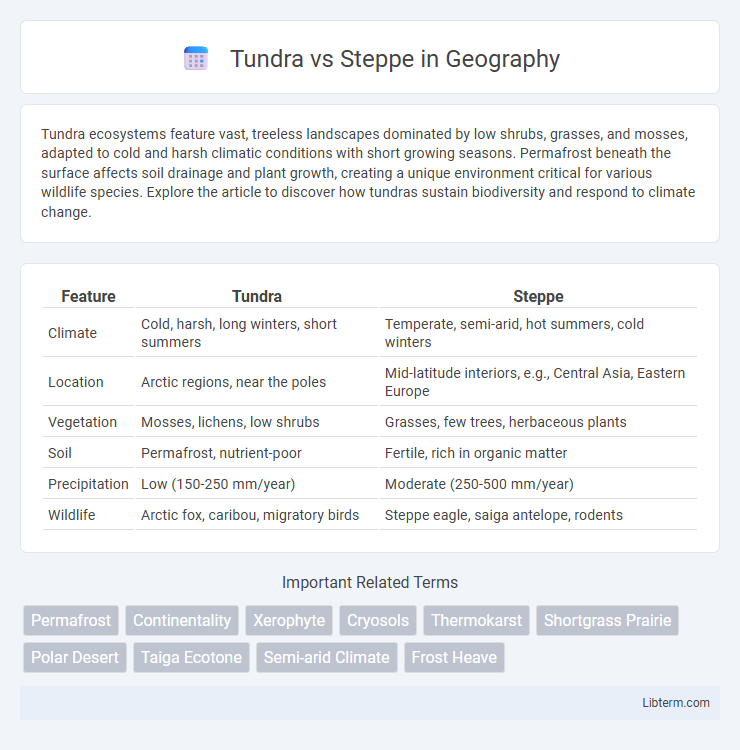Tundra ecosystems feature vast, treeless landscapes dominated by low shrubs, grasses, and mosses, adapted to cold and harsh climatic conditions with short growing seasons. Permafrost beneath the surface affects soil drainage and plant growth, creating a unique environment critical for various wildlife species. Explore the article to discover how tundras sustain biodiversity and respond to climate change.
Table of Comparison
| Feature | Tundra | Steppe |
|---|---|---|
| Climate | Cold, harsh, long winters, short summers | Temperate, semi-arid, hot summers, cold winters |
| Location | Arctic regions, near the poles | Mid-latitude interiors, e.g., Central Asia, Eastern Europe |
| Vegetation | Mosses, lichens, low shrubs | Grasses, few trees, herbaceous plants |
| Soil | Permafrost, nutrient-poor | Fertile, rich in organic matter |
| Precipitation | Low (150-250 mm/year) | Moderate (250-500 mm/year) |
| Wildlife | Arctic fox, caribou, migratory birds | Steppe eagle, saiga antelope, rodents |
Introduction to Tundra and Steppe Biomes
Tundra biomes are characterized by extremely cold temperatures, low precipitation, and a short growing season, supporting hardy vegetation like mosses, lichens, and dwarf shrubs. Steppe biomes feature vast, treeless grasslands with semi-arid climates, moderate precipitation, and nutrient-rich soils ideal for grasses and herbaceous plants. Both biomes play critical roles in Earth's ecology, influencing biodiversity, carbon storage, and climate regulation.
Geographic Distribution
The tundra biome primarily occupies high-latitude regions near the Arctic Circle, including parts of northern Canada, Alaska, Russia, and Scandinavia, characterized by cold temperatures and permafrost. In contrast, the steppe biome is found in mid-latitude areas such as central Eurasia, including Kazakhstan, Mongolia, and parts of Ukraine, featuring semi-arid grasslands with more moderate seasonal climate. Geographic distribution of tundra is closely linked to polar climates, while steppes dominate continental interiors with large temperature variations and limited precipitation.
Climate and Weather Patterns
Tundra climate features long, harsh winters with temperatures often dropping below -30degC and brief, cool summers rarely exceeding 10degC, accompanied by low precipitation primarily in the form of snow. Steppe climate experiences semi-arid conditions with hot summers reaching up to 30degC or higher and cold winters, with moderate precipitation mainly as rain supporting grassland vegetation. The tundra's permafrost and minimal evapotranspiration contrast with the steppe's well-drained soils and more variable rainfall, influencing distinct ecological and weather dynamics in each biome.
Soil Characteristics
Tundra soils are typically acidic, nutrient-poor, and characterized by permafrost layers that limit drainage and root penetration, resulting in thin organic horizons called cryosols. Steppe soils, known as mollisols, exhibit high fertility with deep, dark humus-rich topsoils due to grassland vegetation and moderate moisture availability, supporting extensive agriculture. The key difference lies in permafrost presence in tundra soils versus well-drained, mineral-rich profiles in steppe soils.
Common Vegetation Types
Tundra vegetation primarily consists of mosses, lichens, low shrubs, and grasses adapted to cold, nutrient-poor soils and short growing seasons. Steppe vegetation features drought-resistant grasses, such as feather grass and fescue, along with scattered shrubs adapted to dry, temperate climates with fertile soils. Both biomes lack tall trees but support distinct plant communities shaped by temperature and moisture availability.
Animal Life and Biodiversity
The tundra hosts specialized animal life adapted to extreme cold, including caribou, arctic foxes, and snowy owls, with relatively low biodiversity due to harsh conditions. In contrast, the steppe supports a richer variety of herbivores like saiga antelope and small mammals such as marmots, alongside predators like wolves, reflecting greater biodiversity influenced by milder climate and grassland ecosystems. Both biomes play vital roles in supporting unique food webs and maintaining ecological balance within their specific environmental contexts.
Human Impact and Land Use
Tundra landscapes experience limited human impact due to extreme cold and permafrost, which restrict agriculture and urban development, while indigenous communities engage primarily in traditional reindeer herding and subsistence hunting. Steppe regions, characterized by more temperate climates and fertile soils, support extensive agriculture and livestock grazing, leading to significant land conversion and habitat fragmentation. Both ecosystems face challenges from increasing human activities, but steppe areas see greater land use intensity, contributing to soil degradation and biodiversity loss.
Adaptations to Harsh Conditions
Tundra vegetation exhibits adaptations such as low-growing plants, thick insulating mosses, and permafrost-resistant root systems to survive extreme cold and short growing seasons. Steppe ecosystems feature drought-tolerant grasses with deep root systems that efficiently access water and withstand frequent fires and temperature fluctuations. Both biomes rely on specialized adaptations to endure harsh climates, but tundra plants primarily combat cold and permafrost while steppe flora adapts to arid and semi-arid conditions.
Environmental Challenges
Tundra environments face extreme cold temperatures, permafrost, and limited vegetation growth, leading to fragile ecosystems vulnerable to climate change and human disturbances. Steppe regions experience seasonal droughts, soil erosion, and desertification risks, which threaten grassland biodiversity and agricultural productivity. Both biomes require careful management to mitigate the impacts of harsh climatic conditions and maintain ecological balance.
Conservation Efforts and Future Perspectives
Conservation efforts in tundra regions prioritize protecting fragile permafrost ecosystems and endangered species like Arctic foxes and caribou by establishing protected areas and monitoring climate change impacts. Steppe conservation focuses on preserving vast grasslands, combating desertification, and maintaining biodiversity through sustainable grazing practices and restoration projects for species such as saiga antelope and steppe eagles. Future perspectives emphasize integrating indigenous knowledge with advanced technologies to enhance habitat resilience and promote adaptive management strategies under increasing climate variability in both biomes.
Tundra Infographic

 libterm.com
libterm.com